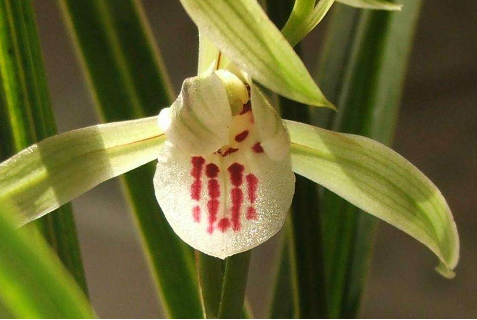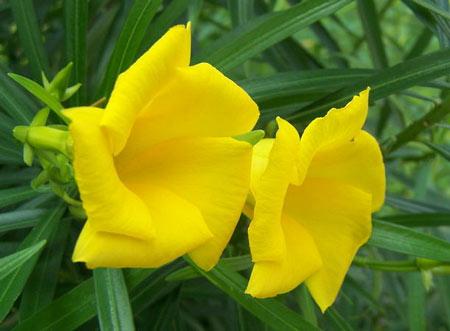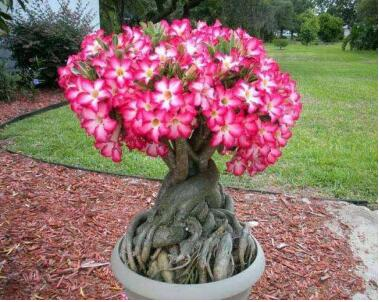Matters needing attention in the Culture of Cold Orchid
1. The leaves of Cymbidium campestris are slender, stomata are many, thin leaves have large contact surface with air, and fresh environment can promote the growth of plants. The cultivated cold orchid medicine is placed away from the oil smoke and the air outlet of the air conditioner. The leaves can be washed frequently with clean water.

2. Usually in August began to divide seedlings, conducive to inhibiting the formation of germination, reduce nutrient consumption, improve its independent survival ability.
3. Cold orchid afraid of heat and cold, autumn and winter period, avoid being blown by strong wind, frost should cover warm.
Cold orchid breeding methods and precautions and everyone said so much, I believe you will be able to raise a good cold orchid after reading, orchid plants will reveal fragrance.
How to raise cold orchid? The cultivation methods and precautions of cold orchid
Picture: Cold Orchid
How to raise cold orchid? The cultivation methods and precautions of cold orchid
[Expert Answer]
Introduction:
Cold orchid is also called winter orchid, because most of its flowering season is during the cold dew and light snow period (October to November), with the characteristics of Ling Han in full bloom and delicate fragrance, so it is named. Cold orchids have different periods due to different origins. They bloom in all seasons. Therefore, cold orchids are divided into spring cold orchids, summer cold orchids, autumn cold orchids and winter cold orchids. The origin of Cymbidium campestris is mainly distributed in Jiangxi, Fujian, Zhejiang, Sichuan, Yunnan, Guizhou, Hunan, Hubei, Guangdong, Guangxi, Anhui, Taiwan and so on. As a major species and rising star of Chinese orchids, Cymbidium oldhamii has attracted more and more attention due to its magnificent leaves, tall flowers, elegant flowers and charming fragrance, and more and more cultivation enthusiasts.
Cold orchid breeding methods and precautions:
1. Planting
Cold orchid grows mostly under dense broad-leaved forest on steep slopes, with less lighting, shallow roots, a thin layer of humus soil covering the roots, and better water permeability. Because of this, when planting, select a high-legged purple sand pot, one third of the bottom of the pot bottom is made of coarse bricks and porous material blocks, the middle part is stirred to one third of the pot with hemp mushroom mud, coarse sawdust, wind fossil, plant stone, pond foundation stone and soybean bricks, and the upper part is stirred with a small amount of rotten soil with the wind fossil and bricks of rice particle volume. Plant seed requirements loose, breathable, wet, warm performance. Special attention should be paid to the survival rate, seedling rate and flowering rate are not high if cultivated with hard plant material, sawdust and humus soil.
2, cultivation: cold orchid because of its growth background and spring, cymbidium have differences, so the cultivation method should be slightly different.
(1) The shade and temperature are similar to those of ink blue. Especially in the high temperature season with strong lighting, we should pay more attention to shading and replenishing water. In addition to this sunny morning or evening should spray scattered foliar water, shading up to 80% or so. So the leaf quality is shiny, the incidence is less; I am in the high temperature season, put the cold orchid on the lower layer of the orchid frame, the frame has spring orchid, cymbidium light, the effect is quite good.
(2) Windproof and frostproof. Autumn and winter for a period of time, to prevent strong wind blowing, frost damage date should be covered with heat preservation.
3) Apply fertilizer. According to the above plant material planting cold orchid general can be less fertilizer, or even no fertilizer, but also in April to June spraying leaves with high nitrogen content of fertilizer, such as flower treasure No. 4, B1 germination agent. From August to October, fertilizer containing phosphorus and potassium is sprayed, such as flowering fertilizer, Huabao No.3, potassium dihydrogen phosphate, etc.
3. Maintenance
Cold orchid can bloom, bloom good flowers, delicate fragrance, maintenance is very critical. Such as dark flowers, lighting should be slightly stronger, plain heart lighting slightly overcast. Flower arrows begin to pull out before flowering, such as careless plant protection, flower bud easily stiff rot off. For this reason, the flower bud of cold orchid is also easy to be bitten by mites. The color luster of the pest is similar to that of the flower bud, which is often not easy to detect. A path must be detected as soon as possible, otherwise the flower will not bloom. Therefore, spray scattering of insecticides such as Huakang 1 and killing chrysanthemum fat can be used to prevent and control. Cold orchid open more in late autumn and early winter, the weather is getting cold, often feel fragrant light and gas is not sufficient, in order to make cold orchid fragrance free and easy, show flowers for a period of time should be more sun warm children, so, even if it is only light fragrance overflowing at night. Cold orchids are fragrant and beautiful in shape, colorful in color, superior in scape, with leaves hanging bow, dense in density, elegant and floating, soft in hardness, and elegant in leaves and flowers. In Chinese orchids, they are unique in attraction and will be valued.
Cold orchid is not easy to raise, because its cultivation is not easy, even "nine deaths for a lifetime" saying, in fact, this is the reason why the cultivation skills are not enough, as long as the cultivation skills of cold orchid, its germination rate is not even lower than spring, cymbidium, the above first agricultural classics Xiaobian for you introduced cold orchid cultivation methods and precautions, there are friends who want to cultivate cold orchid must pay attention to it, carefully read the text to help you Oh.
Cultivation methods and precautions of cold orchid Chinese scientific name cold orchid
Cymbidium Kanran Mak.
kingdom planta
Phylum Angiospermum
Class Monocotyledons
Ophthalmoidea
Koranko
Itacanthinae
Cymbiaceae
Cymbidium
Subgenus Cymbidium
Cymbidium campestris L.
Distribution area Anhui, Zhejiang, Jiangxi, Fujian, Taiwan, Hunan, Guangdong, Hainan, Guangxi, Sichuan,
Cymbidium Kanran Mak. Orchidaceae, orchid plants, plant type slender body, elegant leaves, colorful and varied, long fragrance pure alcohol. Set the beauty of all kinds of orchids in one, gather the aura of all things in one. The plant type of Cymbidium campestris is very similar to that of Cymbidium scandens, but the leaves are thinner, especially at the base, and the leaves are elegant and noble. Leaves 3 - 7 cluster, erect strong, 40 - 70 cm long, 1 - 1.8 cm wide, all green or near the top with fine teeth, slightly shiny. Scape erect, and leaf height or higher than leaf surface, flowers sparsely, there are more than 10 flowers. Petals and sepals are narrow and thin, delicate and lovely, rich in color, yellow green, purple, deep purple and other colors, generally with variegated veins and spots. Flowering 10~12 months, Ling frost cold spit fragrance, really valuable, so there is "cold orchid" name. The fragrance is intense and lasting. 1. Morphological characteristics
Terrestrial plants; pseudobulbs narrowly ovoid, 2-4 cm long and 1-1.5 cm wide, enclosed in leaf bases. Leaves 3-5 (-7), banded, thinly leathery, dark green, slightly glossy, 40-70 cm long, 9-17 mm wide, anterior margin often denticulate, joints 4-5 cm from base. Scape from base of pseudobulb, 25-60 cm long (-80) cm, erect; racemes sparsely 5-12-flowered; floral bracts narrowly lanceolate, lowermost one up to 4 cm long, middle and upper ones 1.5-2.6 cm long, generally subequal to pedicels and ovaries; pedicels and ovaries 2-2.5(-3) cm long; flowers often yellowish green with yellowish lips, also other colors, often intensely fragrant; Sepals sublinear or linear-narrowly lanceolate, 3-5 (-6) cm long, 13.5-5(-7) mm, apex acuminate; petals often narrowly ovate or ovate-lanceolate, 2-3 cm long and 5-10 mm wide; labellum subovate, inconspicuously 3-lobed, 2-3 cm long; lateral lobes erect, more or less amplexicaul, papillate-pubescent; middle lobes larger, recurved, similarly papillate-pubescent above, margin slightly notched; 2 longitudinal folds extending from base to base of middle lobe, upper part inclined inward and conniving to form short tube; stamen 1-1.7 cm long, slightly curved forward, narrowly winged on both sides; pollen mass 4, 2 pairs, broadly ovate.
Capsule narrowly ellipsoid, ca. 4.5 cm long, ca. 1.8 cm wide. Flowering August-December.
Cold orchid period varies according to different regions, usually concentrated in October to November flowering, but there are also July and January flowering, and even April to May flowering, so some people think, cold orchid should have spring cold orchid, summer cold orchid, autumn cold orchid and so on.
2. Growth habits
Born under forest, beside stream valley or on slightly shady, moist, stony soil, elevation 400-*** m.
3. Geographical distribution
Distribution in Anhui, Zhejiang, Jiangxi, Fujian, Taiwan, Hunan, Guangdong, Hainan, Guangxi, Sichuan, Guizhou and Yunnan.
4. Subspecies
The plant type of Cymbidium campestris is very similar to that of Cymbidium scandens, but the leaves are thinner, especially at the base, and the leaves are elegant and noble. Leaves 3 - 7 cluster, erect strong, 4D-70 cm long, 1 - 1.7 cm wide, all green or near the top with fine teeth, slightly shiny. Scape erect, and leaf height or higher than leaf surface, flowers sparsely, there are more than 10 flowers. Petals and sepals are narrow and thin, delicate and lovely, rich in color, yellow green, purple, deep purple and other colors, generally with variegated veins and spots. Flowering 10~12 months, Ling frost cold spit fragrance, really valuable, so there is "cold orchid" name. The fragrance is intense and lasting. Cold orchid bogey heat, but also afraid of cold, southern cultivation must be placed in a cool environment management, China's cold orchid usually by perianth color to differentiate types. There are four kinds: ① green cold orchid;② purple cold orchid;③ purple cold orchid;④ red cold orchid. Among them, the green and red cold orchids are precious. Taiwan produced by the so-called plain heart cold orchid, light green color, belongs to the type of green cold orchid, so far, the number of plain heart cold orchid is very small, the price is very expensive. Its name is "cold fragrance element","wide cold element","cold mountain element". In Japan, the famous products are "Yue Miao" and "Feng Xue". Red cold orchid famous for "sunlight", are rare treasures. In addition, the thread art of Hanlan has been found in Taiwan and Japan, but the quantity is very small. There is only one kind of "Wu Shan Huang" which is successfully cultivated in Taiwan Province.
According to Mr. Peng Shuangsong of Taiwan, two natural hybrids related to Han Lan,"Su Lu Han Lan" and "Chun Lu Han Lan", were discovered only in the past 30 years. Many orchids have been cultivated in Taiwan. The origin of "Sulu Hanlan" is that in 1959, the Japanese discovered orchids similar to Taiwan Hanlan in Tai 'an Township, Miaoli County, near Sulushe, a high mountain compatriot tribe, at an altitude of about 1000 meters. That is, they were collected and cultivated in Japan. As a result, they bloomed in the annual orchid period, and their petals were fatter and wider than those of Hanlan. Therefore, they knew that they were natural hybrids of Taiwan Hanlan and Taiwan Hanlan, so they were named "Sulu Hanlan". After publication, it was widely loved by Japanese Lan family. The leaves of this species are similar to those of Cymbidium frigidum, and can only be identified according to flowering period and flower type. Because it is a first-generation hybrid, it is more fertile and easier to cultivate than the cold orchid, and because the flowers are larger than both parents, the buds are more varied and the flowers are fragrant, so it has spread rapidly in Taiwan and Japan, and more and more growers have been cultivated. Another species, Cymbidium formosanum, is a natural hybrid of Cymbidium formosanum and Cymbidium formosanum. It grows in Pinglin Mountain, Miaocai Mountain and Hualien. This species has dark green leaves, smooth leaves like cymbidium, but shorter leaves than cymbidium, 30 - 50cm long, 0.6 - 0.9cm wide, 20 - 25cm scape, usually one to two flowers, 5 - 6cm in diameter, brown or purple-brown color, strong floral fragrance, like spring orchid, flowering is the same as the annual orchid. The treasure is named "Song Spring".
- Prev

Propagation mode of oleander
The main results are as follows: 1. The way of sowing is simple and straightforward. After planting the seeds in the soil, they are raised in the greenhouse for a period of time, and finally taken out for planting. 2. the striping cuts the branches close to the surface and presses them into the soil, and then it is separated from the mother plant after it takes root. 3. Cut the selected branches and put them into the prepared glassware for holding water.
- Next

2. Matters needing attention in breeding desert roses
1. When watering, make sure that the surface of the soil is dry and re-watered to prevent excessive watering. 2. Beware of poisoning. We should keep in mind that this plant is poisonous. When raising it, don't eat it by mistake to prevent poisoning. Pruning many people will ignore the pruning of desert roses
Related
- Fuxing push coffee new agricultural production and marketing class: lack of small-scale processing plants
- Jujube rice field leisure farm deep ploughing Yilan for five years to create a space for organic food and play
- Nongyu Farm-A trial of organic papaya for brave women with advanced technology
- Four points for attention in the prevention and control of diseases and insect pests of edible fungi
- How to add nutrient solution to Edible Fungi
- Is there any good way to control edible fungus mites?
- Open Inoculation Technology of Edible Fungi
- Is there any clever way to use fertilizer for edible fungus in winter?
- What agents are used to kill the pathogens of edible fungi in the mushroom shed?
- Rapid drying of Edible Fungi

